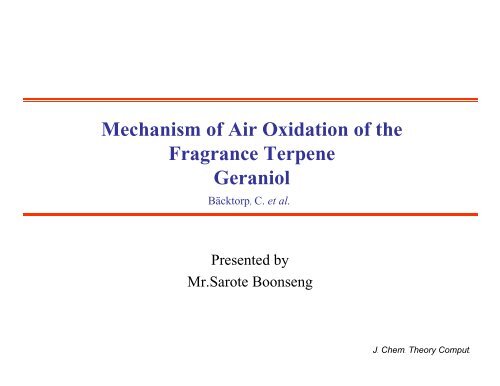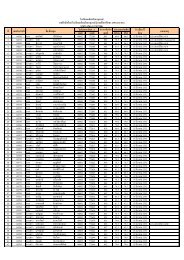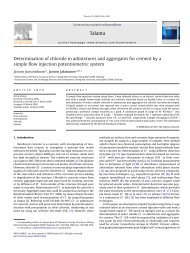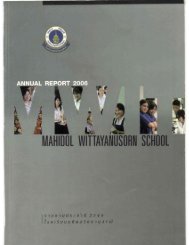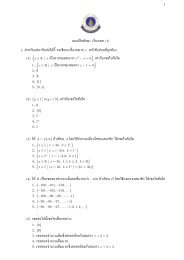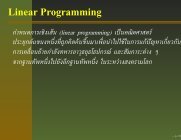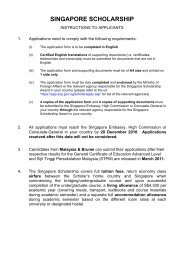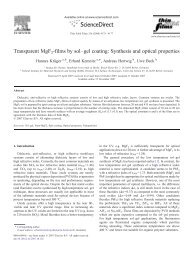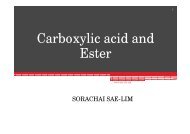Mechanism of Air Oxidation of the Fragrance Terpene Geraniol
Mechanism of Air Oxidation of the Fragrance Terpene Geraniol
Mechanism of Air Oxidation of the Fragrance Terpene Geraniol
Create successful ePaper yourself
Turn your PDF publications into a flip-book with our unique Google optimized e-Paper software.
<strong>Mechanism</strong> <strong>of</strong> <strong>Air</strong> <strong>Oxidation</strong> <strong>of</strong> <strong>the</strong><br />
<strong>Fragrance</strong> <strong>Terpene</strong><br />
<strong>Geraniol</strong><br />
Bäcktorp, C. et al.<br />
Presented by<br />
Mr.Sarote Boonseng<br />
J. Chem. Theory Comput.
Introduction<br />
<strong>Geraniol</strong> is a monoterpenoid. It is <strong>the</strong> primary part <strong>of</strong> rose oil.<br />
HO<br />
IUPAC NAME:<br />
3,7-Dimethyl-2,6-octadien-1-ol<br />
Degraded by O 2 in <strong>Air</strong><br />
http://en.wikipedia.org/wiki/Rose<br />
2
Introduction<br />
H 3 C<br />
H 2<br />
C<br />
H 2<br />
C<br />
CH 2<br />
C<br />
H 3 C C<br />
H 3 C<br />
H 2<br />
H 2<br />
CH 2<br />
H 2<br />
C<br />
CH 2<br />
C<br />
H 2<br />
Cation Radical Anion<br />
Free radical reaction in oxidation process<br />
+O 2<br />
Initiation: RH R<br />
Propagation: R<br />
ROO<br />
ROO + R'H ROOH + R'<br />
Termination: 2R'<br />
non-radical products<br />
3
Introduction<br />
Collision Theory and Activated Complex<br />
http://www.chemguide.co.uk/physical/basicrates/collisions.gif<br />
4<br />
http://academics.triton.edu/faculty/lpytlewski/CHM234Chapter4PDFDiagrams/CHM234Chapter4Images/TransitionState.GIF
Introduction<br />
Thermodynamic<br />
ΔG<br />
= ΔH<br />
−TΔS<br />
ΔG = Gibbs free energy<br />
ΔH = enthalpy<br />
ΔS = entropy<br />
5
Introduction<br />
Structural prediction<br />
Density Functional Theory (DFT)<br />
ĤΨ = EΨ<br />
*<br />
< E >= Ψ Hˆ<br />
Ψ<br />
∫<br />
Erwin Rudolf Josef Alexander Schrödinger<br />
Electronic structure<br />
Electronic properties<br />
Spectroscopic properties<br />
http://en.wikipedia.org/wiki/Image:Erwin_Schr%C3%B6dinger2.jpg<br />
6
Objective<br />
To study <strong>the</strong> mechanism <strong>of</strong> oxidation <strong>of</strong> geraniol.<br />
They focus upon <strong>the</strong> oxidation, which follows a radical<br />
chain process.<br />
HO<br />
<strong>Geraniol</strong><br />
7
Computational Method<br />
Program: Gaussian 03<br />
B3LYP/6-31G(d,p) and B3LYP/6-311+G(2d,p)<br />
To estimate <strong>the</strong> structure and transition structure.<br />
To estimate <strong>the</strong> <strong>the</strong>rmodynamic contribution to <strong>the</strong> enthalpy and free energy.<br />
8
Results<br />
The previous work<br />
Most stable free radical<br />
Hagvall, L.; Ba¨cktorp, C.; Svensson, S.; Nyman, G.; Bo¨rje A.; Karlberg, A.-T. Chem. Res. Toxicol. 2007, 20, 809-814.<br />
9
Results<br />
Autoxidation pathways starting from geraniol.<br />
1 2<br />
3<br />
<strong>Geraniol</strong><br />
A B C<br />
D E F<br />
G<br />
H<br />
I<br />
Product<br />
10
Results<br />
Table 1. Calculated Standard Enthalpy Changes and Standard Gibbs Free Energy<br />
Changes in kcal mol -1 for <strong>the</strong> Reactions.<br />
11
Results<br />
Table 2. Calculated Activation Energies, in kcal mol -1<br />
12
Results<br />
Reaction process<br />
13<br />
Relative energy
Conclusion<br />
The autoxidation products <strong>of</strong> <strong>the</strong> monoterpene geraniol<br />
have been rationalized computationally by investigated <strong>of</strong> radical<br />
chain reaction for a model system. Both propagation steps in <strong>the</strong><br />
accepted mechanism, radical chain transfer and <strong>the</strong> addition <strong>of</strong><br />
O 2 , where found to exergonic reaction.<br />
14
Thank you<br />
15
Basis set<br />
• Basis functions approximate orbitals <strong>of</strong><br />
atoms in molecule<br />
• Linear combination <strong>of</strong> basis functions<br />
approximates total electronic<br />
wavefunction<br />
• Basis functions are linear combinations<br />
<strong>of</strong> gaussian functions<br />
– Contracted gaussians<br />
– Primitive gaussians<br />
16
More basis functions per atom<br />
• Split valence basis sets<br />
• Double-zeta: • Triple-zeta:<br />
17
Add polarization functions<br />
• Allow orbitals to change shape<br />
– Add p orbitals to H<br />
– Add d orbitals to 2nd row atoms<br />
– Add f orbitals to transition metals<br />
• 6-31G(d) - d functions per heavy atoms<br />
– Also denoted: 6-31G*<br />
• 6-31G(d,p) - d functions per heavy<br />
atoms and p functions to H atoms<br />
– Also deonoted: 6-31G**<br />
18
Add diffuse functions<br />
• “Large” s and p orbitals for “diffuse electrons”<br />
– Lone pairs, anions, excited states, etc.<br />
• 6-31+G - diffuse functions per heavy atom<br />
• 6-31++G - diffuse functions both per heavy<br />
atom and per H atom<br />
19


